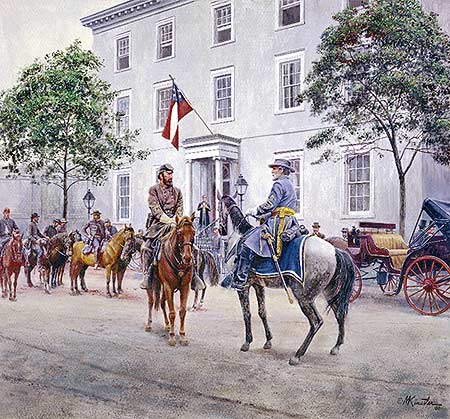The following is an article about the battle from Harper's Weekly, dated January 11, 1862.
By mid-December 1861, nearly 5 months of relative quiet had passed in northern Virginia since the Union defeat at First Bull Run in July. Except for the Federal disaster at Ball's Bluff in October, no significant engagement had occurred between the opposing armies. The Federals, under Maj. Gen. George B. McClellan, a superb organizer, drilled daily in their camps on the Virginia Hills opposite Washington, D.C. 25 miles to the west at Centreville, Gen. Joseph E. Johnston's Confederates also trained.
With the approach of winter, both McClellan and Johnston wrestled with logistical problems. Food and rations for the men and forage for the thousands of horses and mules were a constant need. 5 days before Christmas, both armies sent foraging parties for hay. Both sides selected the same area-the lush farmland west of Dranesville, a town about midway between Alexandria and Leesburg on the Leesburg Turnpike.
At daylight on December 20, the Confederates foraging party, composed of virtually every wagon in Johnston's army rolled out of Centreville, 16 miles south of Dranesville. Brig. Gen. J.E.B. Stuart, with 150 cavalryman, 4 infantry regiments, and an artillery battery, accompanied the wagons as an escort. Almost simultaneously Brig. Gen. E.O.C. Ord left Camp Pierpont with 5 Pennsylvania infantry regiments, a battery of four cannon, and a squadron of cavalry. Ord had been ordered to capture Southern marauders and confiscate forage from loyal Confederates. Having only 12 miles to cover, the Federals entered Dranesville first, about noon. Scattering a few Confederate horsemen, the Union troops occupied the town. An hour later the 1st Pennsylvania Reserve Rifles spotted Stuart's approaching force to the south. Lt. Col. Thomas L. Kane, commander of the Rifles, knew the terrain and quickly moved his regiment to a hill near the intersection of the Leesburg Pike and the Georgetown road. Kane deployed his soldiers while informing Ord of the oncoming Confederates. Stuart's approaching troopers soon exchanged fire with the Pennsylvanians.
Ord and Stuart, both uncertain about the situation, hurried their trailing regiments forward. The Union brigadier deployed 3 regiments on the right of Kane, south of the turnpike, keeping the 10th Pennsylvania and the cavalry squadron north of the road. The Federal battery unlimbered beside the 10th, soon sending its shells toward the deploying Southerners. Stuart meanwhile, aligned his 4 regiments in the woodlands opposite the 4 Pennsylvania regiments. His artillery unit halted behind the infantry and replied to Ord's gunners.
The infantry action began when the 9th Pennsylvania accidentally stumbled into the 1st Kentucky, who had already mistakenly exchanged volleys with the 6th South Carolina. Stuart then attacked with the 11th Virginia and 10th Alabama. The Confederates cleared the woods and drove toward Kane's soldiers, many of whom occupied a 2-story brick house. A 30-minute fire fight ensued, with the Confederates, suffering more. Stuart then shifted the 11th Virginia to the right, but the regiment passed across the front of a concealed company of the 10th Pennsylvania, whose slicing volley staggered the Virginians, sending them back into the woods.
Stuart, with his attack repulsed and certain the wagons were safe, ordered a withdrawal about 3 o'clock. Masked by the smoke and woods, the Confederates extricated themselves without additional loss. Stuart 194 casualties; Ord lost only 68. The next day both commanders returned to their camps.
skip to main |
skip to sidebar

About Me
Blog Archive
-
▼
2008
(104)
-
▼
August
(14)
- The Battle of Dranesville - Part Seven
- The Battle of Dranesville - Part Six
- The Battle of Dranesville - Part Five
- The Battle of Dranesville - Part Four
- Battle of Dranesville - Part Three
- Battle of Dranesville - Part Two
- The Battle of Dranesville
- Major General J.E.B. Stuart by Captain William P. ...
- Major General J.E.B. Stuart by Captain William P. ...
- Major General J.E.B. Stuart by Captain William P. ...
- Major General J.E.B. Stuart by Captain William P. ...
- Minutiae of Soldier Life In the Army of Northern V...
- Minutiae of Soldier Life in The Army of Northern V...
- Minutiae of Soldier Life in the Army of Northern V...
-
▼
August
(14)
Labels
- 2nd Corps (1)
- A.P. Hill (1)
- Anna Morrison (1)
- Army of Northern Virginia (8)
- Battle of Dranesville (8)
- Battle of Fredericksburg (3)
- Brandy Station (1)
- Carlton McCarthy (5)
- Century Magazine (1)
- Chancellorsville (6)
- Charles Marshall (1)
- Clifford Dowdey (3)
- Colonel Wolseley (1)
- Diary (3)
- Douglas Southall Freeman (4)
- Dr. Hunter McGuire (6)
- Dundee (1)
- Emancipation Proclamation (1)
- Equipment (1)
- First Manassas (1)
- Flora Stuart (1)
- Gettysburg (17)
- Gone With the Wind (1)
- Good Friday (1)
- Henry Kyd Douglas (1)
- Henry McClellan (1)
- heroes (2)
- Heros Von Borcke (1)
- James Lane (2)
- James Longstreet (2)
- James Power Smith (5)
- James Robertson (1)
- Jeb Stuart (58)
- Jefferson Davis (1)
- Jesus Christ (1)
- John Imboden (1)
- John Mosby (5)
- Joseph Morrison (2)
- Kansas Historical Quarterlies (3)
- Lee Takes Command (1)
- Lost Cause (1)
- Michael Shaara (2)
- Nannie Price (1)
- Robert E. Lee (15)
- Sandie Pendleton (3)
- Second Manassas (1)
- Seven Days' Battle (3)
- Slavery (1)
- Steven Woodworth (2)
- Stonewall Jackson (26)
- Stuart cavalry (2)
- T.T. Munford (1)
- The Chancellorsville Chronicles (2)
- The Killer Angels (2)
- Theodore Stanford Garnett (6)
- Thomas Connelly (1)
- Throw Away the Scabbard (2)
- Traveller (1)
- Victor Davis Hanson (1)
- West Point Military Academy (1)
- William P. Snow (4)
- William Pendleton (1)
- Yellow Tavern (2)
Some of My Favorite Blogs and Bloggers
High Command

